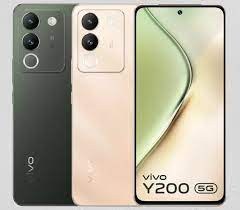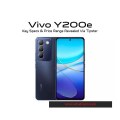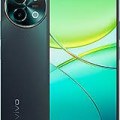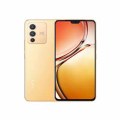Vivo Y200 Price & Specifications



- CPU: Octa-core (2 x 2.0 GHz Cortex-A78 + 6 x 1.8 GHz Cortex-A55)
- RAM: 8GB
- Storage: 128GB
- Display: AMOLED Capacitive Touchscreen, 16M Colors, Multitouch
- Camera: Dual Camera: 64 MP, f/1.8, (wide), PDAF, OIS + 2 MP, f/2.4, (depth), Ring-LED flash
- OS: Android 13 OS
Vivo Y200 Specs & All Features
General
| Device Type | Android |
| Model | Vivo Y200 |
| Announced | Dec 31, 2023 |
| Released | Dec 31, 2023 |
| Status | Available |
| Price | 94999 |
Design
| Type <strong>Design Type</strong> called form factor refers to a mobile phone's size, shape, and style as well as the layout and position of major components of phone. There are three major form factors seen in mobile phones => bar phones, folding phones and sliding phones. | Bar |
| Dimensions | 162.4 x 74.9 x 7.7 mm |
| Weight | 190 g |
| Colors |
Jungle Green, Desert Gold |
Network
| 2G Network |
SIM1: GSM 850 / 900 / 1800 / 1900 SIM2: GSM 850 / 900 / 1800 / 1900 |
| 3G Network |
HSDPA 850 / 900 / 2100 |
| 4G Network |
LTE band 1(2100), 5(850), 8(900), 40(2300) |
| 5G Network 5G Network | SA/NSA |
| SIM <strong>SIM</strong> (Subscriber Identity Module) is a small card that contains mobile network subscriber's account information. This allows the phone using the card to attach to a mobile network. The SIM card is most commonly associated with GSM and UMTS mobile networks. Moving a SIM card from one phone to another allows a subscriber to switch mobile phones without having to contact their mobile network carrier. SIM cards can also be used by a phone to store limited amounts of data, such as phone numbers and text messages. | Nano SIM |
| Dual SIM | Dual Sim, Dual Standby (Nano-SIM) |
Display
| Display Type <strong>Display Technology => </strong> A number of display technologies and types used in mobile phones => TFT (Thin Film Transistor), IPS (In-Place Switching), OLED (Organic Light Emitting Diode), AMOLED (Active-Matrix Organic Light-Emitting Diode), Super AMOLED (an even advanced version of AMOLED), Resistive Touchscreen (Resistive touchscreens contain two layer of conductive material with a very small gap between them which acts as a resistance), Capacitive Touchsceen (Capacitive touchscreen technology consists of a layer of glass coated with a transparent conductor) | AMOLED Capacitive Touchscreen, 16M Colors, Multitouch |
| Size | 6.67 Inches |
| Resolution | 1080 x 2400 Pixels (~395 PPI) |
| Pixel Density <strong>Pixel Density (PPI)</strong> is refers to the concentration of pixels on a particular display, measured in pixels per inch (ppi). Pixel density is calculated by dividing the diagonal pixel resolution of a display by its diagonal size, higher pixel density better display quality. | 395 PPI |
| Touch Screen | yes |
| Display Protection <strong>Display Protection => </strong> Gorilla Glass is a special alkali-aluminosilicate glass shield with exceptional damage resistance that helps protect mobile displays from scratches, drops, and bumps of everyday use, It is always better to go for a smartphone with Gorilla Glass for that added protection and peace of mind. | yes |
| Features |
120Hz, 800 nits (peak) |
Media
| Audio Playback | yes |
| Video Playback | yes |
| Video Out | yes |
| FM Radio | yes |
| Alert Types | yes |
| Ring Tones | yes |
| Loudspeaker | yes |
| Handsfree | yes |
Camera
| Main Camera | Dual Camera: 64 MP, f/1.8, (wide), PDAF, OIS + 2 MP, f/2.4, (depth), Ring-LED flash |
| Image | yes |
| Video | yes |
| Camera Features |
Geo-tagging, Phase detection, Panorama, HDR, Video (1080p@30fps) |
| Flash <strong>Flash Light => </strong> There is commonly two types of flash lights are used in camera mobile phones, LED Flash (LED flash offers lower power consumption with drive circuitry that takes up very little room, LEDs can be strobed faster than any other light source), Xenon Flash (xenon flash produces an extremely intense full-spectrum white light for a very short duration) | yes |
| Front Camera Front Camera | 16 MP, f/2.0, (wide), Video (1080p@30fps) |
Software
| Operating System <strong>OS => </strong> Every computer system run on a base software called Operating System (OS). Operating System controls all basic operations of the computer (such as smartphone, PDAs, tablet computers and other handheld devices). The Operating System allows the user to install and run third party applications (apps), apps are used to add new functionality to the device. | Android 13 OS |
| User Interface <strong>UI</strong> or user interface of a device is the look and feel of the on-screen menu system. How it works, its color scheme, how it responds to button presses, all of these things are part of the user interface. | Funtouch OS 13 |
Hardware
| Chipset <strong>Chipset</strong> is a group of integrated circuits designed to perform one or a more dedicated functions, often with real time computing constraints, Popular smartphones are equipped with more advanced embedded chipsets that can do many different tasks depending on their programming. | Qualcomm SM4375 Snapdragon 4 Gen 1 (6 nm) |
| CPU <strong>CPU</strong> (Central Processing Unit) mostly known as processors, CPU processes instructions in order to carry out certain functions that make your device operate properly. Processors are often described as the brain of computers, smartphones and tablets, Smartphones and tablets rely on processors to carry out their every task, Processors are an incredibly important factor in selecting any type of computing device, including your smartphone. | Octa-core (2 x 2.0 GHz Cortex-A78 + 6 x 1.8 GHz Cortex-A55) |
| GPU <strong>GPU</strong> (Graphics Processing Unit) is a single-chip processor designed to rapidly manipulate and alter memory to accelerate the creation of images in a frame buffer intended for output to a display, This includes things such as lighting effects, object transformations, and 3D motion. | Adreno 619 |
| RAM (Memory) | 8GB |
| Internal Storage <strong>Internal Storage</strong> is a data storage space (flash memory) mostly used in smartphones, tablets and other electronic devices where operating system, apps, music, photos, videos, files and other user data Is stored. | 128GB |
| Card Slot <strong>Memory Card Slot</strong> is a special slot for inserting a memory card. Memory cards allow you to expand the phone's built-in memory, A memory card (sometimes called a flash memory card or a storage card) is a small storage medium used to store data such as text, pictures, audio, and video, for use on small, portable or remote computing devices such as mobile phones, mp3 players, digital cameras. | No |
| Sensors <strong>Sensors</strong> are electronic components that detects and responds to some type of input from the physical environment. The specific input could be light, heat, motion, moisture, pressure and location, The output is generally a signal that is converted to use in computing systems, a location sensor, such as a GPS receiver is able to detect current location of your electronic device. |
Accelerometer, Compass, Fingerprint (under display, optical), Gyro, Proximity |
Connectivity
| Bluetooth <strong>Bluetooth</strong> is a wireless communications technology for exchanging data between mobile phones, headsets, computers and other network devices over short distances without wires, Bluetooth technology was primarily designed to support simple wireless networking of personal consumer devices. | v5.1 with A2DP, LE |
| Wi-fi <strong>Wi-Fi</strong> is a popular wireless networking technology using radio waves to provide high-speed network connections that allows devices to communicate without cords or cables, Wi-Fi is increasingly becoming the preferred mode of internet connectivity all over the world. | Wi-Fi 802.11 a/b/g/n/ac, dual-band |
| Wi-fi Hotspot | yes |
| USB | USB Type-C 2.0, OTG |
| GPS <strong>GPS</strong> The Global Positioning System is a satellite-based radio navigation system, GPS permits users to determine their position, velocity and the time 24 hours a day, in all weather, anywhere in the world, In order to locate your position, your device or GPS receiver must have a clear view of the sky. | Yes + GPS, GLONASS, GALILEO, BDS, QZSS |
| NFC <strong>NFC</strong> (Near field communication) is a set of standards for smartphones and similar devices to establish peer-to-peer radio communications with each other by touching them together or bringing them into proximity, usually no more than a few inches. | No |
Data
Battery
| Battery Type <strong>Battery Type => </strong> Cell phones run on various kinds of batteries depending on the manufacturer, phone size or shape and features. There are basically four types of cell phone batteries => Lithium Polymer, Lithium Ion, Nickel Metal Hydride and Nickel Cadmium. | Li-Poly (Lithium Polymer) |
| Capacity <strong>Battery Capacity</strong> is a measure (typically in Amp-hr) of the charge stored by the battery, and is determined by the mass of active material contained in the battery. The battery capacity represents the maximum amount of energy that can be extracted from the battery under certain conditions. | (Li-Po Non removable), 4800 mAh |
The Vivo Y200 is a great mobile phone launched by Huawei. It comes with many impressive features that make it a good choice for everyone. Here is a detailed look at the Vivo Y200 Powerspecs.
Vivo Y200 Design and Build:
The Vivo Y200 runs on the latest Android 13 with Funtouch OS 13. It has a sleek design with dimensions of 162.4 x 74.9 x 7.7 mm and weighs 190 grams. The phone is available in two beautiful colors: Jungle Green and Desert Gold. The color-changing back panel is a unique feature that adds to its style.
Vivo Y200 Display:
The phone has a large 6.67-inch AMOLED capacitive touchscreen with a resolution of 1080 x 2400 pixels. This gives you clear and vibrant visuals. The display supports a high refresh rate of 120Hz and can reach a peak brightness of 800 nits, making it perfect for watching videos and playing games.
Vivo Y200 Performance:
The Vivo Y200 Powerspecification includes a powerful Qualcomm SM4375 Snapdragon 4 Gen 1 chipset with an octa-core CPU. This consists of 2 high-performance Cortex-A78 cores running at 2.0 GHz and 6 power-efficient Cortex-A55 cores running at 1.8 GHz. The Adreno 619 GPU ensures smooth graphics performance, making it ideal for gaming and multitasking.
Vivo Y200 Memory and Storage:
The phone comes with 128GB of built-in storage and 8GB of RAM, which ensures smooth performance and ample space for your apps, photos, and videos. Unfortunately, there is no option to expand the storage with a microSD card.
Vivo Y200 Camera:
The Vivo Y200 Powercamera setup includes a dual-camera system on the back. It has a 64 MP main camera with an aperture of f/1.8, featuring PDAF and OIS for sharp and stable photos. There is also a 2 MP depth sensor with an aperture of f/2.4. The front camera is 16 MP with an aperture of f/2.0, perfect for selfies and video calls. Both cameras support video recording at 1080p@30fps.
Vivo Y200 Battery:
The Vivo Y200 is powered by a 4800 mAh non-removable battery. It supports fast charging at 44W, which can charge the phone from 1-50% in just 28 minutes as advertised. This ensures you can quickly top up your battery and get back to using your phone without much delay.
Vivo Y200 Connectivity and Other Features:
For connectivity, the Vivo Y200 Powerspecs include dual SIM support, 4G LTE, Wi-Fi 802.11 a/b/g/n/ac, Bluetooth 5.1, GPS, and a USB Type-C 2.0 port with OTG support. It also has an FM radio, 3.5mm audio jack, and supports high-quality audio with 24-bit/192kHz output.
Other notable features include an under-display fingerprint sensor, accelerometer, compass, gyroscope, and proximity sensor. The phone is IP54 dust and water-resistant, ensuring durability. It also has a glass front and back, adding to its premium feel.
The Vivo Y200 is a powerful and feature-rich smartphone that offers great value for money. With its impressive specs and stylish design, it is a great choice for anyone looking for a reliable and high-performing mobile phone. Check out the Vivo Y200 Powerprice in Pakistan and read more Vivo Y200 Powerreviews to see if this phone is the right fit for you.
By following the above structure and using the given keywords, you can easily write a detailed yet simple article about the Vivo Y200














